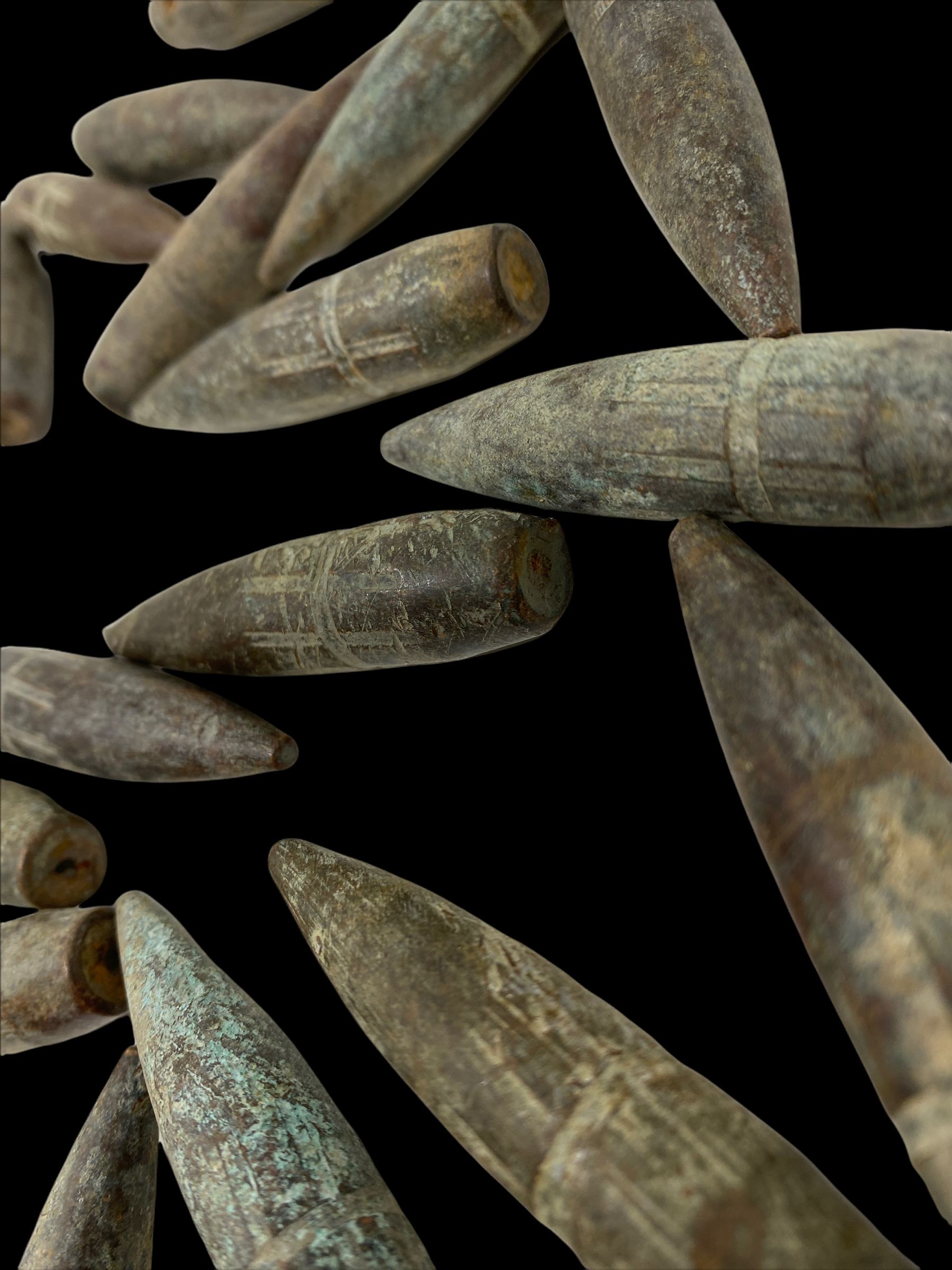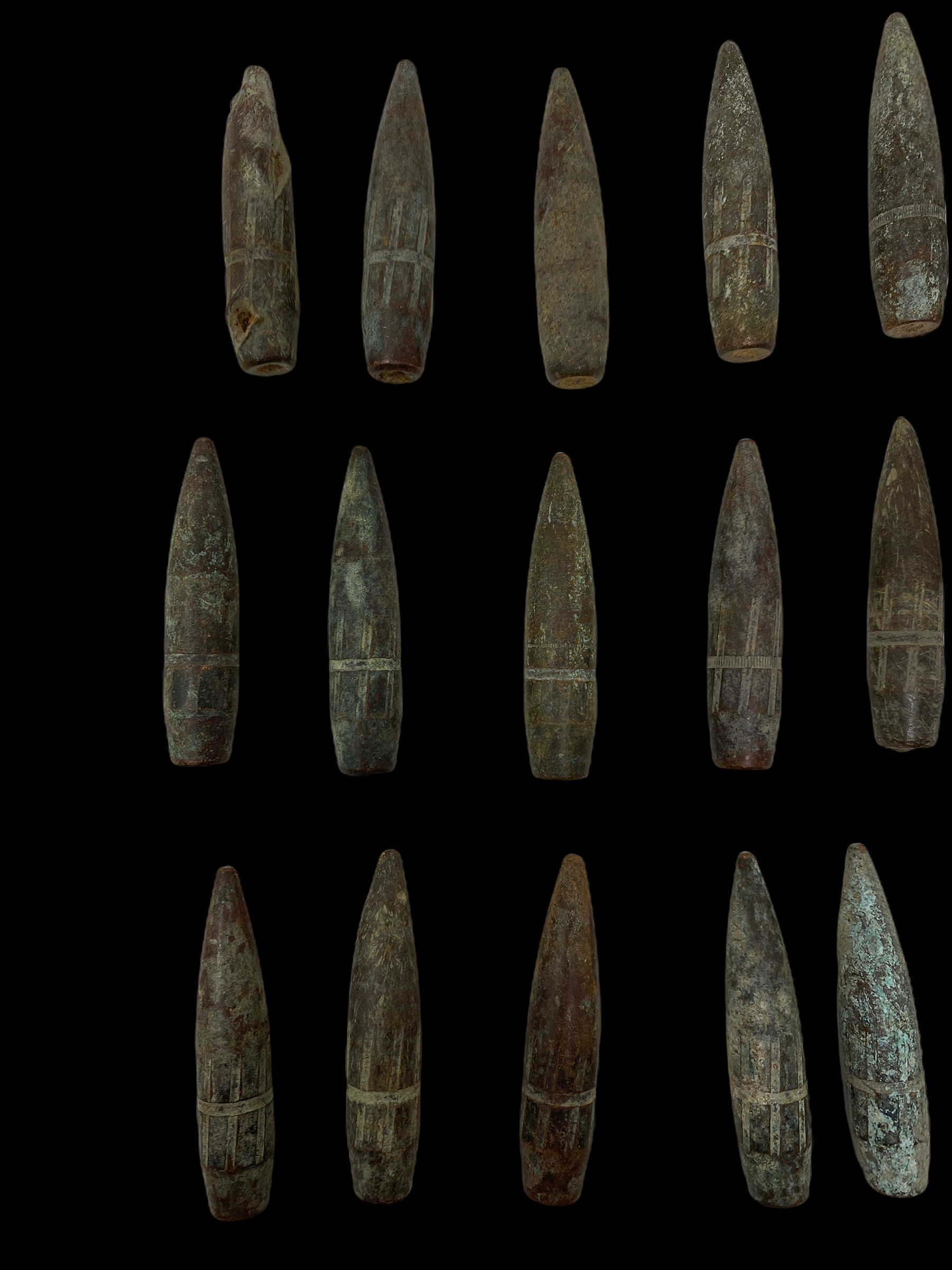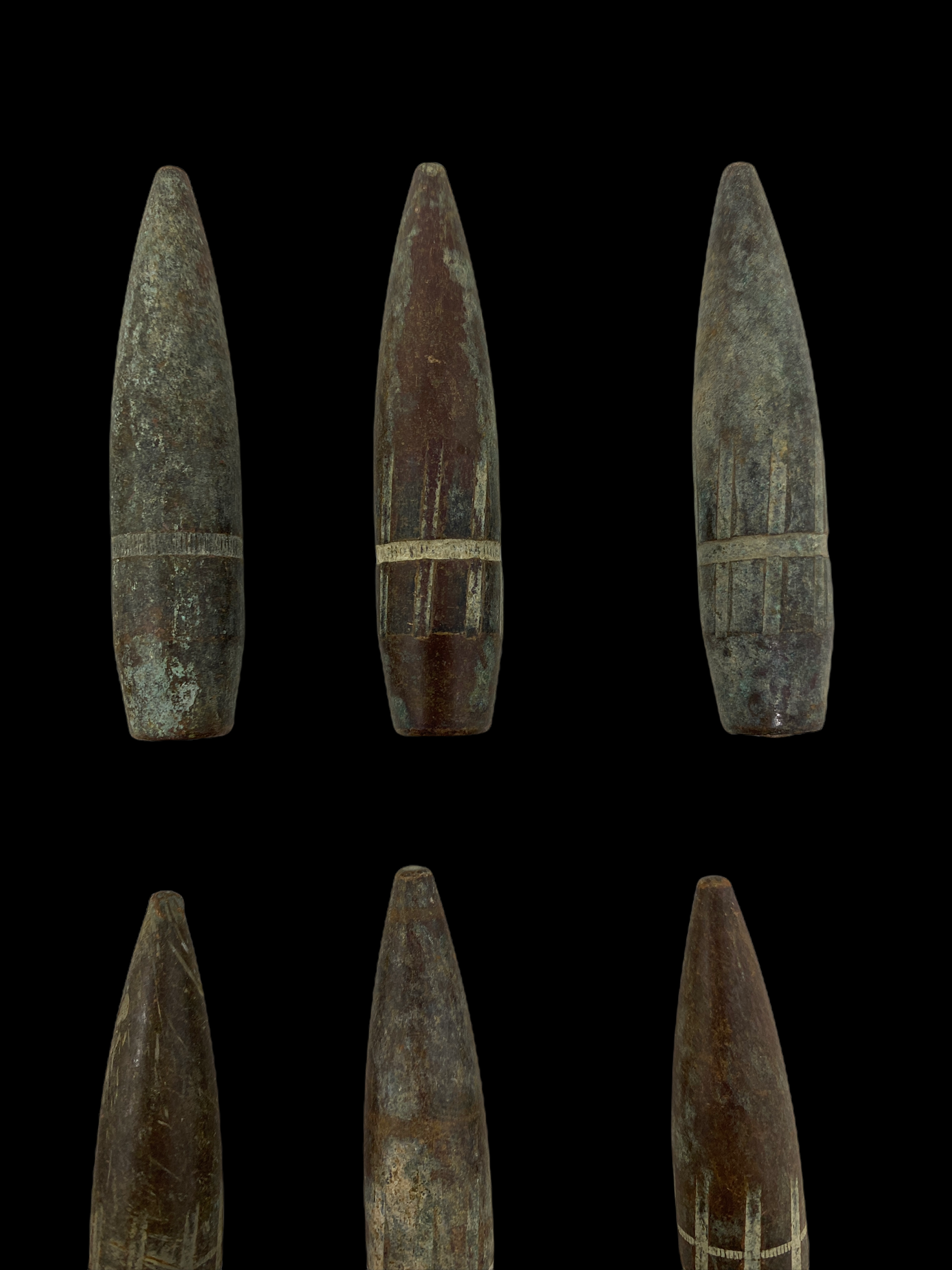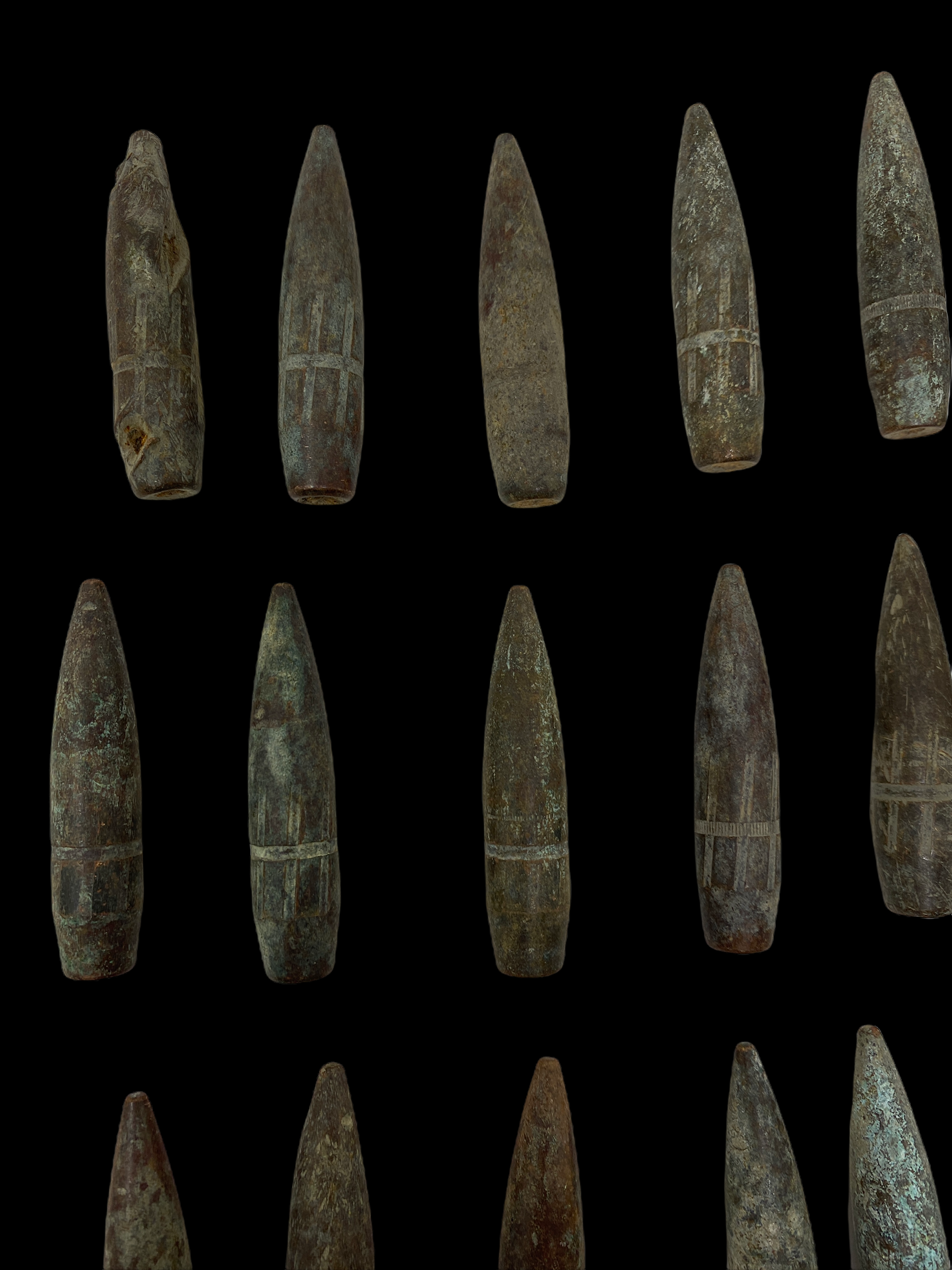RARE! WWII Battle of the Bulge 101st Airborne Bastogne Recovered Large .50 Caliber Machine Gun Bullet U.S. Relic (1 Randomly Selected)












RARE! WWII Battle of the Bulge 101st Airborne Bastogne Recovered Large .50 Caliber Machine Gun Bullet U.S. Relic (1 Randomly Selected)
Comes with hand-signed C.O.A. and a full historical write-up
This authentic Battle of the Bulge 101st Airborne Division fired relic was recovered near the infamous city of Bastogne.
When purchasing an artifact from this collection you will receive ONE RANDOMLY SELECTED artifact from the lot (group) of relics you see in the photos. The photo represents the exact quantity that is originally available as well as one of the exact randomly selected relics that you will receive. Meaning that one of the artifacts you purchased and receive is pictured in these exact photos. This would make an AMAZING gift for any WWII or HISTORY collector.
Called “the greatest American battle of the war” by Winston Churchill, the Battle of the Bulge in the Ardennes region of Belgium was Adolf Hitler’s last major offensive in World War II against the Western Front. Hitler’s aim was to split the Allies in their drive toward Germany. The German troops’ failure to divide Britain, France, and America with the Ardennes offensive paved the way to victory for the allies.
This incredibly rare and museum-grade WWII Battle of the Bulge battlefield fired machine gun bullet was recovered directly from the 101st Airborne Division combat assault areas on the Bastogne region of the Battle of the Bulge battlefield. Laying exactly where it was was fired and recovered years later, this U.S. heavy machine gun bullet was fired during the Ardennes Offensive during the Battle of the Bulge. It was here were for six brutal weeks, from December 16, 1944, to January 25, 1945, the assault also called the Battle of the Ardennes, took place during frigid weather conditions, with some 30 German divisions attacking battle-fatigued American troops across 85 miles of the densely wooded Ardennes Forest.
This U.S. machine gun bullet serves as an eerie reminder of those 1 million-plus Allied troops, including some 500,000 Americans, fought in the Battle of the Bulge, with approximately 19,000 soldiers killed in action, 47,500 wounded and 23,000-plus missing. About 100,000 Germans were killed, wounded, or captured.
Detailed History of the Battle of the Bugle (December 16th, 1944 - January 25th, 1945):
In one final, desperate gamble of the war, Hitler enacted his Ardennes Offensive and drove a wedge into the Allied lines towards Antwerp - but little else came from the initiative.
By the end of 1944, the Allied advance across Europe was such that the front was held in check at its ends by two large armies - the Canadians and English to the North and the Americans and General Patton to the south. While the Canadian and English forces succeeded in taking the critical port-city of Antwerp from the Germans, the Americans shored up the battle lines and were now targeting the ever-important Rhone River with German territory just beyond. In between the two concentrated forces lay a thin line of some 80,000 Allied troops.
The reason for this thin grouping of support was largely explained by its location, this in the thick of the seemingly impenetrable Ardennes Forest. It was a long-held belief that the area was ill-suited for any sort of open warfare and the Allies utilized this feeling and the surrounding terrain to concentrate critical forces to the fighting elsewhere along the Front.
However, Hitler had developed other plans when constructing his Ardennes Offensive. The ultimate goal was to reach the post city of Antwerp and disrupt the Allied front and their much- needed supply lines along the way. The hope was to split the Canadian, British and American forces from one another and their logistical means to stay alive, thusly providing Germany with the element of surprise and a foothold to mounting a future assault to drive the enemy back. The selection of enacting the assault during the European Winter would only add to the element of surprise.
The surprise was unveiled on December 16th, 1944 when the German Army opened up in one of their largest displays of artillery bombardment ever. Mechanized forces of the German 5th and 15th Panzer armies, as well as the 6th SS and 7th Army, attacked the US VIII forces in a line between Aachen and Bastogne. The German surprise held up well and the Allies reeled at the advance. However, some contingents such as the US 2nd Division at Elsenborn and 99th Division at Malmedy held their ground. The last German blitzkrieg was underway as a grand total of 200,000 German personnel were mustered into a singular fighting force, encompassing both battle-hardened troops such as those of the Waffen-SS and non-combatants from across the German territories.
Part of the German advance was led by the cold and calculating Colonel Joachim Peiper who saw it fit to order his troops to execute any prisoners they take. Some 100 Americans alone were shot where they stood at Malmedy, this under the direct order of Peiper himself. While this soothed his embittered German troops to an extent, it only served to rile the Americans who, having received word of the atrocities, now produced an unparalleled fighting spirit when facing the Germans.
Both forces inevitably butted heads at the small town of Bastogne. The Germans were held in place by Allied tank destroyers and determination while the Americans dug in for weeks of intense fighting utilizing whatever cover and supplies were made available. American General Omar Bradley ultimately recognized Bastogne to be the battlefield of choice by the Germans and committed elements of General Courtney Hodges' 1st Army and General Patton's 4th Armored Division to the town in an effort head off any further German advance. Allied reserves were called into play and the fabled 101st Airborne ("The Battered Bastards of the 101") was airdropped into Bastogne to aid in its defense - and make military history in the process. The 82nd Airborne took the task at St Vith.
The Allied lines were fractured and independent defenses soon sprung about. Poor weather cover ensured that the Allied would not be counting on air support for the time being. Being that the Germans had lost air superiority by this time, the playing field was more or less leveled. Instead, Allied artillery hammered at the flanks of the German advance where possible and the German thrust was eventually held before reaching Dinant, some 60 miles from the Ardennes Offensive starting point. After holding onto Bastogne for a full week while being encircled by the German Army, the 101st repelled the final german thrust. The very next day, Patton's armor arrived to ensure the town was firmly in Allied hands. In true airborne style, the 101st never admitted to needing any such help from Patton's armored forces.
British General Montgomery's 29th Armored Brigade met up with the American 2nd Armored Division to hold the point of deepest German penetration in check. The Battle of the Bulge - the last major German offensive - was stopped. By mid-February of 1945, all gains by the German Army were undone and the war would be over by the end of April with Hitler dead by his own hand.
The Ardennes Offensive would cost Germany some 88,000 of her soldiers while American paid the hefty toll of losing 77,000 of their own.